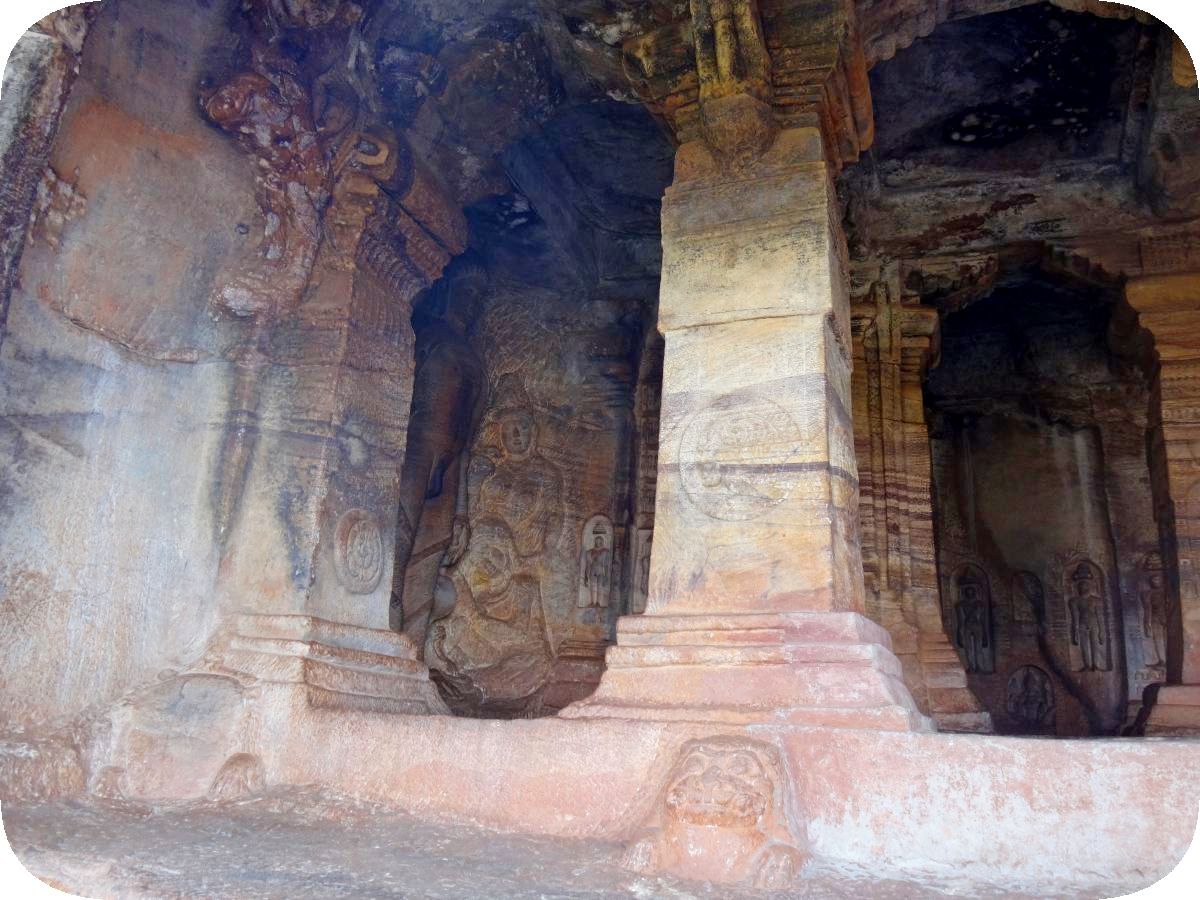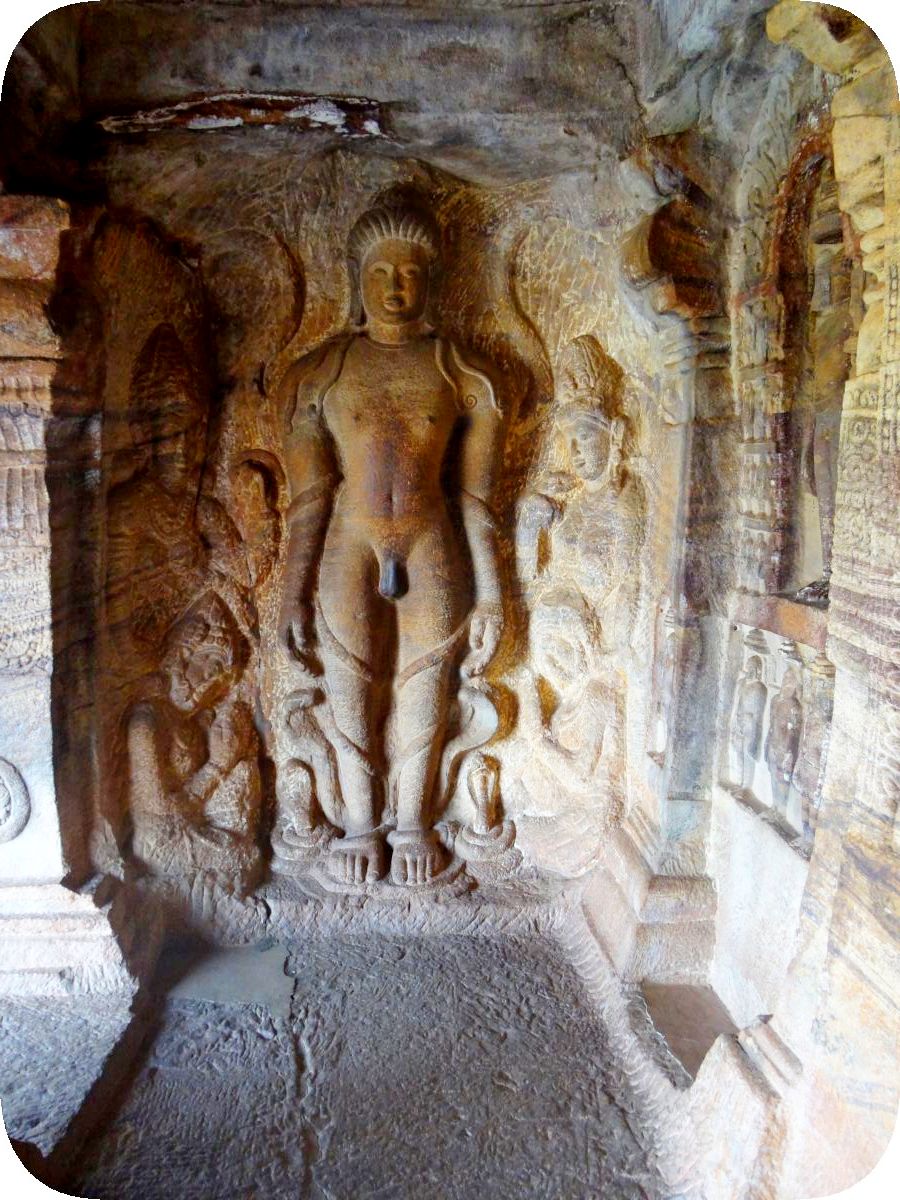HELLO.HIVE!
I told about the history of Jainism last time, and today we will see what is inside the Jain cave temple in Badami. There is no bas-relief on the left side of the temple in the lobby; it was clearly destroyed, presumably by Muslim invaders.
The temple is desecrated and services are not held here, it is just a museum. The stones in the Jain temple are striped, this is such a funny texture of the rock in this place.
Although all the temples in one way or another have stripes in the structure of the stones.
And on the right in the pillared lobby is a figure with a 7-headed snake overhead. Which of the Tirthankaras loved snakes? Parshvanata (Parshvanath, Parshvanath, Parshva)! 23rd tirthankar out of 24. Most likely, the statue was once painted blue. At the age of 30, Parshvanath renounced the mundane and became an ascetic monk. By the way, Parshva was born in the iconic Indian city of Varanasi. And he reached Moksha (enlightenment) at the age of 100 (!), Right on the Sammet-Shikhar mountain. The snakes accompany him in gratitude for the salvation from the fire. The snakes became his Yaksha and Yakshin. These are the patron beings of the Tirthankaras.
Faces are worn out, colors are dull ...
To the left of the vestibule there is a large figure of Tirthankar Jain Gomateshvara, or, more simply, Bahubali (“Strong hands”). He is the son of Rishabha, the first Tirthankara of Jainism. In the last article, I described in more or less detail the essence of Jainism and its terms. The topic of Jainism is worthy of respect, read it, it's interesting! There are many legends and myths about Bahubali. According to one of them, Bahubali fought with his brother Bharat and defeated him, but decided to give up the kingdom and go to the monks. For a whole year he meditated in the standing position of the kayozarga. Plants twined around his feet, and birds made nests in his hair and beard. Brother Bharat came and bowed before him. Bahubali interrupted his meditation out of bitterness, which caused his brother to be humiliated. It was then that Bahubali gave up his 4 hostile karmas and became enlightened. According to another version, the sisters came to Bahubali and began to sing a song, urging his brother to descend from his elephant. Bahubali realized that the elephant is his pride. Understanding the fact of his pride both liberated Bahubali and gave him moksha. But there is also a legend that it was Brother Bharat who stood and meditated for a long time, deciding to become a monk. And the question with the kingdom was never resolved. Bahubali could not accept the kingdom without his brother's renunciation. Here Bahubali grabbed the meditating bart with his “strong hands” (hence the name Bahubali), demanding renunciation. The brother could not give it, because he did not consider himself a ruler. And then the enraged Bahubali grabbed his brother and wanted to throw him off the cliff into the abyss. He grabbed it and immediately realized what kind of fierce bullshit he was doing. Bahubali lowered his brother to the ground and began to meditate himself ... and got moksha. It's funny that my brother meditated for years and did not become enlightened, and Bahubali only had a little time. Here is the power of illumination!
In any case, in the finale of the legends, Bahubali attained moksha and became a siddha with a liberated soul. Bahubali is very revered among the followers of Digambara. Therefore, it is not at all surprising that the king is naked. This is Jainism of the Digambara branch, and therefore all the statues here are without clothes. And this temple is very different from 3 other cave temples in Badami. Although asceticism, but with the genitals.
..to be continued..
Ich habe letztes Mal über die Geschichte des Jainismus erzählt, und heute werden wir sehen, was sich im Jain-Höhlentempel in Badami befindet. Auf der linken Seite des Tempels in der Lobby befindet sich kein Basrelief, das vermutlich von muslimischen Invasoren zerstört wurde.
Der Tempel ist entweiht und Gottesdienste finden hier nicht statt, es ist nur ein Museum. Die Steine im Jain-Tempel sind gestreift, dies ist eine so lustige Textur des Felsens an diesem Ort.
Obwohl alle Tempel auf die eine oder andere Weise Streifen in der Struktur der Steine haben.
Und rechts, im Säulenvorraum, steht eine Gestalt mit einer 7-köpfigen Schlange über dem Kopf. Welcher der Tirthankaras liebte Schlangen? Parshvanata (Parshvanatha, Parshvanath, Parshva)! 23. Tirthankar von 24. Höchstwahrscheinlich war die Statue einmal blau gestrichen. Im Alter von 30 Jahren verzichtete Parshvanath auf das Alltägliche und wurde asketischer Mönch. Parshva wurde übrigens in der legendären indischen Stadt Varanasi geboren. Und er erreichte Moksha (Erleuchtung) im Alter von 100 Jahren (!) Direkt am Sammet-Shikhar-Berg. Die Schlangen begleiten ihn als Zeichen der Dankbarkeit für die Rettung aus dem Feuer. Die Schlangen wurden seine Yaksha und Yakshin. Dies sind die Schutzwesen der Tirthankaras.
Gesichter werden gelöscht, Farben sind langweilig ...
Links vom Vorraum befindet sich eine große Figur von Jaina Gomateshwara, Tirthankara oder einfacher Bahubali („Starke Hände“). Er ist der Sohn von Rishabha, dem ersten Tirthankara des Jainismus. Im letzten Artikel habe ich das Wesen des Jainismus und seine Begriffe mehr oder weniger detailliert beschrieben. Das Thema Jainismus verdient Respekt, lesen Sie es, es ist interessant! Es gibt viele Legenden und Mythen über Bahubali. Einer von ihnen zufolge kämpfte Bahubali mit seinem Bruder Bharat und besiegte ihn, beschloss jedoch, das Königreich aufzugeben und zu den Mönchen zu gehen. Ein ganzes Jahr lang meditierte er im Stehen der Kayozarga. Pflanzen schlangen sich um seine Füße und Vögel machten Nester in seinen Haaren und seinem Bart. Bruder Bharat kam und verneigte sich vor ihm. Bahubali unterbrach seine Meditation aus Bitterkeit, was dazu führte, dass sein Bruder gedemütigt wurde. Zu diesem Zeitpunkt gab Bahubali seine 4 feindlichen Karmas auf und wurde erleuchtet. Nach einer anderen Version kamen Schwestern nach Bahubali und begannen ein Lied zu singen, wobei sie seinen Bruder aufforderten, von seinem Elefanten abzusteigen. Bahubali erkannte, dass der Elefant sein Stolz ist. Als er die Tatsache seines Stolzes verstand, befreite er Bahubali und gab ihm Moksha. Es gibt aber auch eine Legende, dass es Bruder Bharat war, der lange Zeit stand und meditierte und beschloss, Mönch zu werden. Und die Frage mit dem Königreich wurde nie gelöst. Bahubali konnte das Königreich ohne den Verzicht seines Bruders nicht akzeptieren. Hier packte Bahubali den meditierenden Bruder mit seinen „starken Händen“ (daher der Name Bahubali) und forderte Entsagung. Der Bruder konnte es nicht geben, weil er sich nicht als Herrscher betrachtete. Und dann packte der wütende Bahubali seinen Bruder und wollte ihn von der Klippe in den Abgrund werfen. Er packte es und merkte sofort, was für ein wilder Mist er tat. Bahubali ließ seinen Bruder zu Boden sinken und begann sich zu meditieren ... und bekam Moksha. Es ist lustig, dass mein Bruder jahrelang meditierte und nicht erleuchtet wurde und Bahubali nur wenig Zeit hatte. Hier ist die Kraft der Beleuchtung!
Auf jeden Fall erreichte Bahubali im Finale der Legenden Moksha und wurde ein Siddha mit einer befreiten Seele. Bahubali wird unter den Anhängern von Digambara hoch verehrt. Daher ist es nicht verwunderlich, dass der König nackt ist.
Dies ist der Jainismus des Digambara-Zweigs, und daher sind alle Statuen hier ohne Kleidung. Und dieser Tempel unterscheidet sich sehr von 3 anderen Höhlentempeln in Badami. Obwohl Askese, aber mit den Genitalien
..Fortsetzung folgt..




